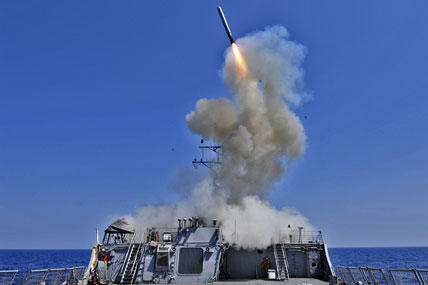Four U.S. Navy destroyers in the Eastern Mediterranean are armed with hundreds of Tomahawk cruise missiles ready to fire into Syria should President Obama order the strike, U.S. defense officials said Thursday.
"Navy assets in the Eastern Mediterranean are ready to provide support but we have not received any tasking from higher authority," a defense official told Military.com
The four Arleigh Burke-class Destroyers in the region – the USS Barry, USS Ramage, USS Mahan, and USS Gravely – can each house up to 96 Tomahawk Land Attack Missiles, the officials confirmed.
First used in Desert Storm in 1991, Tomahawks are all-weather, long range, subsonic cruise missiles able to strike high-value or heavily defended land targets. The missiles are a high-speed, low-altitude weapon designed to evade enemy air defenses – in part by flying lower to the ground and using precision GPS navigation systems.
U.S. and British commanders fired 221 Tomahawk missiles in 2011 from warships at the outset of the attack on Libya and Moammar Gadhafi. The missiles struck about 20 sites and helped destroy Libya's air defense system.
Tomahawk missiles weigh 3,500 pounds with a booster and can travel at subsonic speeds up to 550 miles per hour. They are just over 18-feet long and have an 8-foot, 9-inch wingspan.
The most current variant of the weapon, called the Block IV, provides commanders with the ability to re-route missiles in flight, if needed, using GPS technology. The Block IV weapon also provides a "loiter" capability, meaning a missile can linger near an intended target if necessary before striking.
In addition, Block IV Tomahawks give commanders the ability to provide a single-frame image of a target area or other areas of interest along the missile flight path.
The initial operational capability, or IOC, for Block IV Tomahawks was in 2004. Both Block IV Tomahawks and their immediate predecessor, Block III missiles, have a target range out to about 900 nautical miles.
"The destroyers in the Eastern Mediterranean have the capability to carry both Block III and Block IV missiles," defense officials said.
One analyst said Tomahawks, if used against the Assad regime, could be effective against certain strategic targets.
"It is effective against light to medium hard targets, anything from vehicles, radar sites, enemy air defenses, military headquarters and aircraft in the open," said Daniel Goure, vice president of the Lexington Institute, a Virginia-based think tank.
There are some inherent limitations with the Tomahawk as well, Goure said. They might not be as effective against hardened or very well-fortified targets. Also, if the U.S. military wanted to disable runways and airfields, they may need a weapon with more "terminal velocity," according to Goure.
"Because they come in low, Tomahawks can't get terminal velocity. What you need is something that will come in from 10-, 20- or 30-thousand feet to put a hole in the runway kinetically and then blow up," Goure said.
Although there is no current program to develop a next-generation Tomahawk, the Navy is always looking at improving technology, service officials said.
"While there is currently not a funded capability improvement effort within the budget, the Navy continues to assess emerging technologies for incorporation into Tomahawk in future budget cycles," service officials said.
The 2,000th Tomahawk missile was launched by one of the destroyers now in the Eastern Mediterranean -- the USS Barry -- against an air defense target in Libya in 2011, during Operation Odyssey Dawn.
Tomahawks were also used in the NATO Operation in Kosovo in 1999, Operation Desert Strike in 1996, Desert Fox in 1998, Operation Enduring Freedom in 2001 and Operation Iraqi Freedom in 2003.
The weapons have also been fired in various "Global War on Terror Contingency Operations," defense officials explained.
At least two of the destroyers now deployed in the Eastern Mediterranean – the USS Gravely and the USS Mahan -- are what's called "Aegis" destroyers, meaning they have the radar and Standard Missile 3-based capability to conduct Ballistic Missile Defense missions.
In theory, having Aegis-capable destroyers nearby could prove worthwhile should the Syrian regime attempt some kind of attack on U.S. forces, Goure explained.
The Aegis ships are carrying a mix of Standard Missile 2s - the air defense weapon designed to intercept approaching threats near the ship such as enemy missiles, and SM-3s -- the missile defense interceptor designed to intercept a ballistic missile in space, Goure explained.
"If I have that mix of SM 2s or SM 3s, I can defend myself against anti-ship cruise missiles, an air attack or a boat attack. If the Syrian Air Force launches an air strike," Goure said.
The Navy is also operating two aircraft carrier strike groups nearby in the Arabian Gulf -- the USS Nimitz and the USS Truman.
These CSGs include a range of naval assets, to include aircraft such as F-18 Super Hornets and other weaponry. The USS Truman carrier strike group is supported by two destroyers and two cruisers – the USS Bulkeley, USS Mason, USS San Jacinto, and the USS Gettsyburg.




























